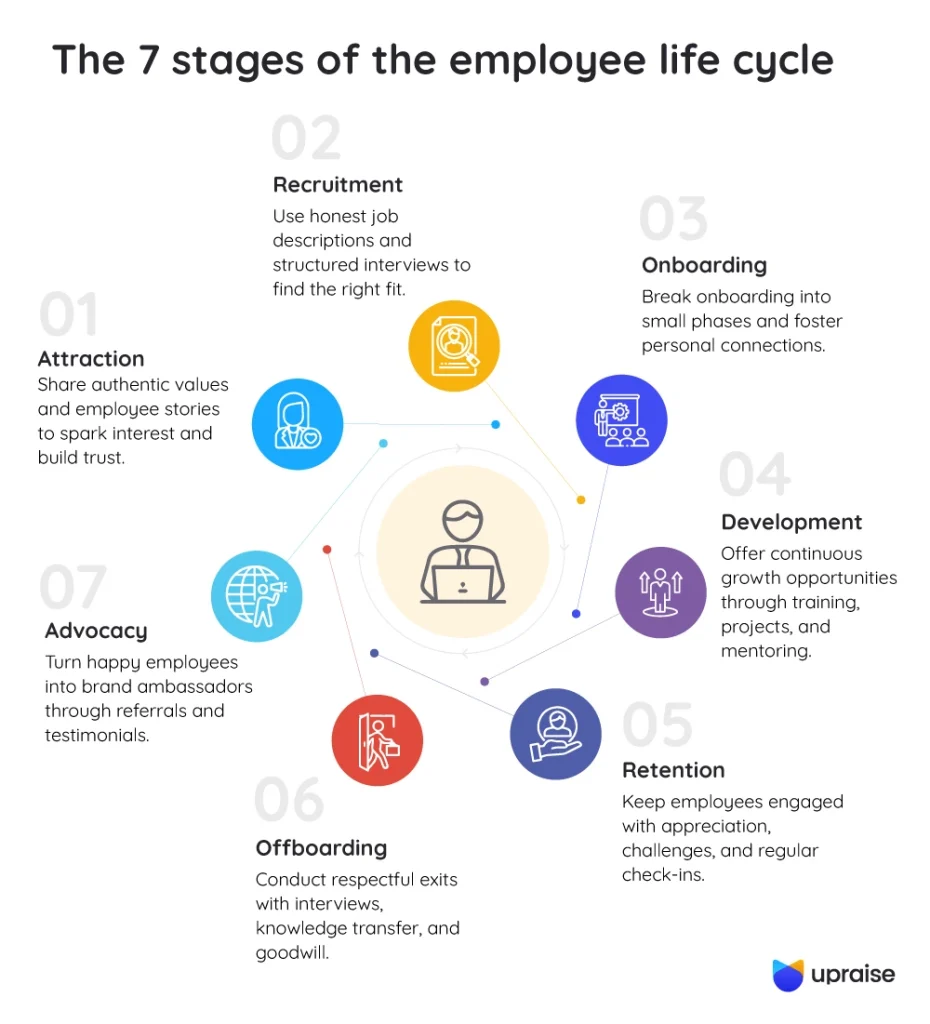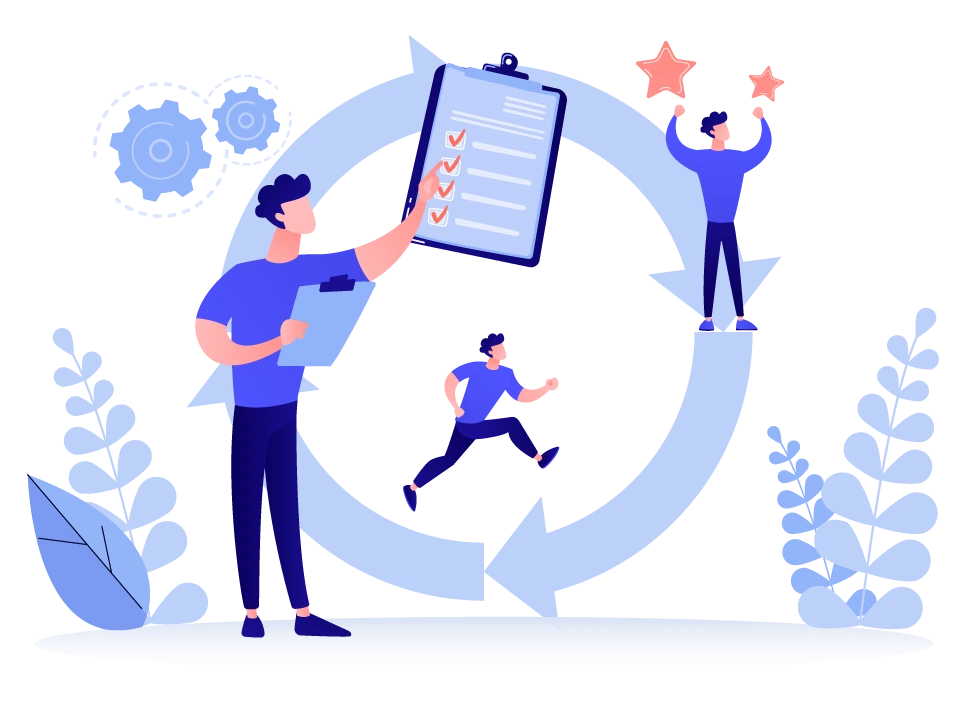What makes one team feel like a well-oiled machine, while another keeps losing people faster than it can hire them? It often comes down to how well an organization understands and supports the employee life cycle stages.
Many businesses pour time and resources into recruitment but overlook what happens before a candidate is hired. That’s where the cracks begin to show. People feel disconnected, growth stalls, and valuable team members walk out the door.
Gallup reports that only 31% of U.S. employees were engaged at work in 2024 — the lowest figure in a decade. That drop isn’t just a morale issue—it’s a wake-up call for how we design the employee life cycle model from start to finish.
In this blog, we’ll break down the 7 stages of the employee life cycle, explore how to measure success at each phase, and share practical ideas to improve every step along the way.
And while no single tool can fix everything, having a centralized approach that connects feedback, development, and performance management in one place can make it easier to turn these stages into consistent practices.
What is the employee lifecycle?
As a leader, you can use the employee life cycle model to better understand each stage of your employee’s journey — from their first interaction with your company to the moment they move on. It’s an HR framework that helps you assess the employee experience, identify engagement drivers, and make more informed decisions at every stage of the journey.
When you pay attention to these lifecycle stages, you start to notice what’s working and what’s not. Noticing when employees feel valued or when they begin to pull back, helps you take action early and create a workplace where people want to stay.
Case Study: SoftServe’s Employee Journey Project
To see what the employee life cycle model looks like when put into practice, consider how SoftServe, a global IT firm, approached it. It’s a great example.
The company launched an Employee Journey Project to better understand what their people experienced across the employee lifecycle stages.
Instead of guessing, they mapped each phase, from attraction to exit, and pinpointed where employees felt friction or disconnection. This helped them invest in the right places: clearer communication, smoother transitions, better development support.
Over time, apart from improving HR processes, the initiative shaped a company culture that people wanted to stick around for. By mapping each stage of the employee lifecycle, leaders gained the visibility to act early and the insights to make meaningful changes.
The 7 stages of the employee life cycle
The 7 stages of the employee life cycle give structure to what might otherwise feel like an unpredictable people process. From that first moment of interest to the final goodbye, each phase in the employee journey presents a chance to build trust.
Here’s how each of the life cycle stages shapes the bigger picture:

Stage 1: Attraction
This is the moment when someone first notices your company. Maybe it’s a social post, a review, or a job board listing. Either way, they’re forming an impression. Sharing clear company values and real employee experiences, like day-in-the-life posts or team milestones, helps potential candidates understand what it’s actually like to work with you. When those stories feel genuine, they spark interest and build trust.
Stage 2: Recruitment
It’s not just about filling roles. Honest job descriptions, thoughtful conversations, and structured interviews help you find people who will thrive, not just fill a seat. Timely communication and clarity go a long way in creating a respectful talent life cycle experience.
Stage 3: Onboarding
Those first weeks shape the rest of the employee experience. Break onboarding into smaller, achievable “sprints” (short, structured onboarding phases) and create space for personal connection. Simple gestures, like a buddy system or a warm welcome, can leave a lasting impression.
Stage 4: Development
Growth shouldn’t feel optional — it should feel expected. Whether it’s a mentoring session, a cross-team project, or setting personal OKRs (Objectives and Key Results) that feed into team goals, every opportunity to learn helps employees feel invested and seen.
Stage 5: Retention
People don’t stay because of coffee machines or Friday pizzas. They stay because they’re heard, challenged, and appreciated. In fact, a McLean & Co. report found that 93% of engaged employees consistently go above and beyond their job expectations, while only 46% of disengaged employees do the same.
Make regular check-ins the norm, not the exception. Catch concerns early, and don’t wait for anniversaries to show appreciation.
Stage 6: Offboarding
Departing team members deserve a positive experience, too. Structured exit interviews, knowledge transfer, and maintaining goodwill can turn former employees into brand advocates. Treat departures with the same care as arrivals.
Stage 7: Advocacy
The final stage is where former or current employees share their positive experiences externally. Through alumni networks, employee referral programs, or organic testimonials, happy employees naturally become ambassadors. A good reputation in the market will attract new talent through authentic word-of-mouth.
Mastering these employee life cycle stages is about creating meaningful and lasting connections with your people.
How to optimize all employee life cycle stages?
Recognizing the 7 stages of the employee life cycle is only half the work – optimizing each phase is where real impact happens.
Here’s how you can strengthen each of the employee life cycle phases:
1. Attraction
- Share real employee stories on your website and social channels.
- Promote your company values clearly through job posts and brand messaging.
Examples in action: Glassdoor reviews, behind-the-scenes team videos, and authentic employee testimonials on LinkedIn all help bring your culture to life. These formats boost employer branding credibility and improve candidate conversion.
2. Recruitment
- Simplify application processes to avoid frustrating great candidates.
- Use structured interviews that assess real competencies, like collaboration, adaptability, or ownership.
Examples in action: Define OKRs before hiring and align interview panels around them. Competency-based questions linked to role outcomes improve decision-making and reduce hiring mismatches.
3. Onboarding
- Break onboarding into a 30-60-90 day plan (often called sprints) with clear, achievable milestones.
- Assign mentors or onboarding buddies to guide new hires through their first few months.
Examples in action: Set a 30-day OKR like “Complete product training and shadow two client calls” to give new hires clarity and direction early on.
4. Development
- Encourage personal OKRs linked to team and company goals.
- Offer microlearning opportunities through internal LMS platforms, LinkedIn learning, or even team-led knowledge sessions—bite-sized learning sticks better than one-off workshops.
Examples in action: Set quarterly OKRs like “Complete two LinkedIn Learning modules on Agile practices” to tie learning goals directly to business needs.
5. Retention
- Build a culture of continuous feedback, not just yearly reviews.
- Celebrate small wins regularly because recognition fuels motivation more than occasional awards.
Examples in action: Use monthly eNPS (employee Net Promoter Score) check-ins and weekly 1:1 templates to track sentiment over time, not just performance.
6. Offboarding
- Conduct honest, respectful exit interviews to gather insights for future improvements.
- Build an alumni network—on Slack, LinkedIn, or a dedicated alumni page—so former team members stay connected. Engaged alumni often return as rehires or refer top talent, making them a valuable long-term asset.,
Examples in action: Document exit feedback directly in Jira and track trends, like reasons for departure or suggestions for improvement, to strengthen future retention efforts.
7. Advocacy
- Invite employees to share experiences through blogs, case studies, or events.
- Recognize ambassadors publicly; when appreciation is authentic, people are more likely to speak up. Strong advocacy can boost Glassdoor ratings, increase referral hires, and drive engagement on employer-branded content.
Examples in action: Highlight peer-nominated employees in internal newsletters or feature their success stories on LinkedIn to strengthen employer branding from within.
Optimizing the employee life cycle stages enhances employee satisfaction and significantly boosts your organization’s bottom line. A Forbes study shows that companies with strong onboarding programs improve new hire retention by 82%, highlighting the impact of structured lifecycle strategies on employee retention.
Conclusion: Managing the employee life cycle stages
The real value of the employee life cycle lies in intentionally guiding the employee experience from start to finish. When each stage is thoughtfully designed – with growth, recognition, and feedback built in – you don’t just retain talent; you build lasting relationships that benefit your brand long after someone has moved on.
FAQs
How can you optimize the recruitment stage in the employee life cycle?
Focus on clear job descriptions, structured interviews, timely communication, and creating a positive candidate experience that reflects your company culture.
What metrics should you track to measure the effectiveness of each stage of the employee life cycle?
Track time-to-hire, onboarding satisfaction, training completion rates, retention rates, exit interview insights, and employee advocacy scores for a full view.
How does employee engagement affect the entire employee life cycle?
Higher engagement leads to better retention, faster development, stronger performance, and more positive advocacy, influencing every employee life cycle stage.
What are the best practices for managing the separation stage of the employee life cycle?
Conduct respectful exit interviews, capture feedback, ensure smooth knowledge transfer, and maintain positive alumni relationships to strengthen long-term brand reputation.




